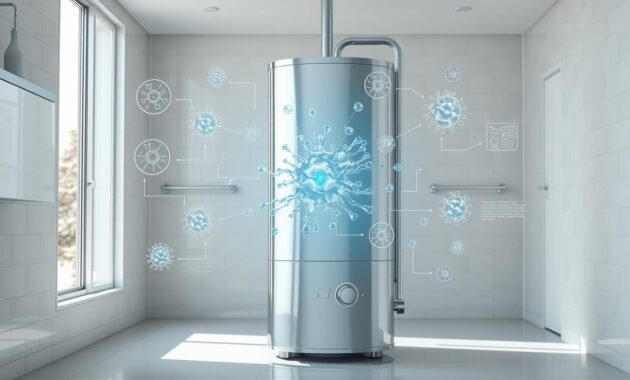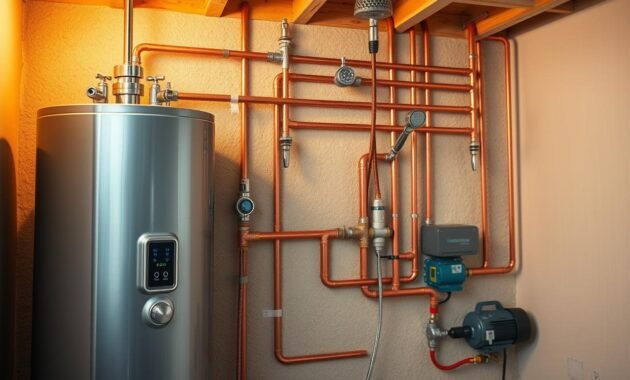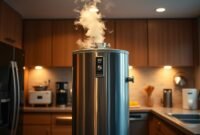Are you trying to find the perfect hot water heater temperature? It’s a challenge many face daily. It’s about safety, comfort, and saving energy. But, it can also lead to scalding, bacterial growth, and high bills.
I’m here to help you understand the best water heater settings. Whether you’re at home or in a nursing facility, knowing the right temperature is key. It keeps your loved ones safe and saves you money. Let’s explore expert tips and practical solutions together.

Understanding Hot Water Heater Temperature Basics
Water heaters are essential in our daily lives, using 14% to 18% of home energy. Knowing how your water heater works can improve comfort and save energy.
Rad also: Advantage Of A Tankless Water Heater
Essential Components of Water Heating Systems
Every water heater has important parts that work together. These include:
- Thermostat for water heater thermostat adjustment
- Heating element or gas burner
- Insulated storage tank
- Temperature and pressure relief valve
Impact of Temperature Settings on Performance
The temperature setting on your water heater affects its performance and energy use. A safe temperature is between 120-140 degrees Fahrenheit. If it’s too high, you waste energy. If it’s too low, there’s a risk of bacteria.
Energy Consumption Considerations
Choosing an energy-efficient water heater means knowing how temperature impacts energy use. Lower temperatures save money but must be safe and comfortable. Modern water heaters have programmable settings to help save energy without losing hot water quality.
By managing your water heater’s temperature, you can find the right balance. This balance is between comfort, safety, and saving energy.
The Ideal Temperature Range for Safety and Comfort
Choosing the right hot water heater temperature is key to keeping your family safe. Most water heaters are set at 140 degrees by default. Yet, experts suggest setting it to 120 degrees for most homes.
Knowing the right temperature range is vital to avoid scalding. Water at 120 degrees is warm enough but not too hot. It’s a perfect balance for safety and everyday use.
- Safe temperature range: 120-140 degrees
- Recommended setting: 120 degrees for most homes
- Scalding prevention starts with proper temperature control
Every household is different. Families with young kids or the elderly should keep water temperatures low. On the other hand, some healthcare places might need water hotter to fight bacteria.
| Temperature | Risk Level | Recommended Use |
|---|---|---|
| 120 degrees | Low Scalding Risk | Residential Homes with Children |
| 140 degrees | High Scalding Risk | Specialized Healthcare Settings |
It’s wise to talk to a professional plumber to find the best temperature for your home. They can offer advice tailored to your needs, ensuring safety, comfort, and possibly even bacterial control.
What Temperature Should a Hot Water Heater Be Set At
Choosing the right temperature for your water heater can be tricky. I’ll help you find the ideal settings for safety, comfort, and energy efficiency. Knowing the right temperature is key for your home’s performance and your family’s health.
The Department of Energy suggests setting your water heater to 120 degrees. This is a great balance to prevent bacterial growth and avoid scalding risks.
Default Manufacturing Settings
Most water heaters are set to 140 degrees by default. This is actually higher than recommended. Such a setting can cause several problems:
- Increased risk of scalding
- Higher energy consumption
- Accelerated mineral buildup in tanks
Optimal Temperature Recommendations
| User Group | Recommended Temperature | Rationale |
|---|---|---|
| Standard Households | 120°F | Energy efficient, reduced scalding risk |
| Homes with Immunocompromised Individuals | 140°F | Kills more bacteria |
| Tankless Water Heater | 120-125°F | Prevents mineral buildup |
Expert Guidelines for Different Settings
For tankless water heaters, I suggest keeping the temperature between 120-125 degrees. This range helps avoid mineral buildup and meets most household needs.
Setting your water heater to 150 degrees is not recommended for homes. It wastes energy and increases scalding risks. Always choose safety and efficiency when adjusting your water heater’s temperature.
Preventing Bacterial Growth in Water Heaters

Understanding bacterial growth in hot water systems is key to keeping them safe and healthy. Legionella bacteria are a big health risk, mainly when water temperatures are not right.
Research shows Legionella can grow and multiply in temperatures between 68°F and 122°F. This is a dangerous range where keeping water hot and safe is a challenge. The best temperature to stop bacteria growth is usually above 120°F.
- Legionella thrives in temperatures between 95°F and 115°F
- Bacteria can be effectively killed at temperatures above 131°F
- Lower temperatures increase bacterial reproduction risks
To keep your home safe, it’s smart to manage your water heater’s temperature. This means checking the temperature often and finding the right balance between saving energy and stopping bacteria.
Experts say to use shock treatments sometimes. This means raising the water temperature to 140°F to kill off bacteria. It adds extra protection beyond just keeping the temperature high.
By knowing how to use hot water wisely and doing regular maintenance, you can make your hot water system safer and more efficient. This helps protect your family from health risks.
Safety Considerations for Elderly Residents
Hot water safety is key when caring for the elderly. Older adults are at high risk of scalding injuries. Even a short exposure can cause severe burns. Knowing the right water temperature is vital to prevent accidents and keep the system efficient.
To protect seniors from water injuries, a detailed plan is needed. Using smart temperature control can lower risks and save on medical costs.
Scalding Prevention Measures
- Set water heater temperature between 120-130°F to minimize burn risks
- Install anti-scald valves near fixtures to reach the tap safely
- Use thermostatic mixing valves to regulate water temperature
- Regularly check water temperature with accurate thermometers
Temperature Control Solutions
Today’s technology helps keep water safe for the elderly. Programmable thermostats let you control the temperature precisely. This reduces burn risks and keeps the water comfortable.
Special Requirements for Nursing Homes
Nursing homes must follow strict safety rules. They need to check their water systems often, maintain them well, and train staff. This is all part of keeping residents safe.
By following these steps, caregivers can make a safer, more comfortable place for the elderly. This protects them from water injuries and keeps the hot water system efficient and affordable.
Energy Efficiency and Cost Savings
Understanding how your water heater affects your bills is key. I’ve found smart ways to cut costs and keep your home warm without wasting energy.
Lowering your water heater’s temperature can save a lot on bills. Just a 10°F drop could save 3% to 5% each year. This small change can make a big difference in your energy use.
- Recommended temperature settings for energy savings: 120°F
- Potential annual savings: $30-$50 per household
- Reduced energy consumption without compromising comfort
Different water heaters use more or less energy. It’s wise to compare your current one with newer models. Modern ones have better insulation and smart controls.
| Water Heater Type | Energy Efficiency Rating | Estimated Annual Savings |
|---|---|---|
| Traditional Tank | Low | $0-$20 |
| Tankless | High | $100-$200 |
| Heat Pump | Very High | $200-$300 |
Using these energy-saving tips can save you money and help the environment. Even small changes can add up to big savings over time.
Temperature Adjustment Methods and Best Practices
Learning how to adjust your water heater thermostat is key to keeping your hot water just right. Knowing the right steps can balance comfort, safety, and save energy.
I’ll show you how to test and set your hot water heater’s temperature correctly. These steps work for both gas and electric water heaters, helping you find the ideal setting.
Step-by-Step Temperature Testing
- Find the thermostat on your water heater
- Turn off power to the water heater before testing
- Use a reliable digital thermometer for precise measurements
- Run hot water from the nearest faucet for 3-5 minutes
- Measure the water temperature at the tap
Professional Calibration Tips
Experts suggest certain methods for adjusting water heater temperatures accurately. Here’s a guide to help:
| Heater Type | Recommended Method | Typical Temperature Range |
|---|---|---|
| Electric Water Heater | Use screwdriver to adjust thermostat dial | 120-140°F |
| Gas Water Heater | Adjust temperature control knob | 120-130°F |
| Tankless Water Heater | Digital control panel adjustment | 105-140°F |
Adjusting your water heater thermostat correctly can avoid burns and save energy. Always be careful and consider a pro if you’re not sure.
Maintaining Consistent Hot Water Supply

Getting hot water to all taps in a big house or apartment can be tough. It’s annoying and wasteful when water takes too long to get there. Knowing how you use hot water helps fix these problems.
A hot water circulating system is a great fix. It keeps water warm in your pipes. This means no long waits and less water wasted.
- Reduces water waste by minimizing wait times
- Provides instant hot water at distant fixtures
- Improves overall home water efficiency
Here are some tips to make hot water better:
- Install a hot water recirculation pump
- Insulate hot water pipes to keep heat in
- Adjust water use to save energy
| System Type | Installation Cost | Annual Savings |
|---|---|---|
| Dedicated Return Line | $500-$1,000 | $100-$200 |
| Retrofit Circulation | $300-$500 | $50-$150 |
With these tips, you can make your hot water system better. You’ll save water and energy. Your home will be more efficient and meet your hot water needs.
Common Temperature-Related Issues and Solutions
Water heaters can face many temperature problems. These issues affect their performance and efficiency. Knowing these problems helps homeowners keep their water heaters working well.
With tankless water heaters, some common temperature issues can happen. I’ll explain the most common problems and offer solutions:
- Inconsistent Water Temperature
- Check thermostat calibration
- Inspect heating elements
- Verify water pressure settings
- Sediment Buildup Problems
- Flush water heater annually
- Install water softener
- Replace deteriorating components
Fixing temperature problems needs careful checking. Start with simple steps before getting a pro.
| Issue | Potential Cause | Recommended Solution |
|---|---|---|
| Water Too Hot | Thermostat malfunction | Recalibrate or replace thermostat |
| Lukewarm Water | Sediment accumulation | Drain and flush water heater |
| Fluctuating Temps | Heating element wear | Professional inspection recommended |
For tankless water heaters, watch out for flow rate and mineral buildup. Regular upkeep can stop most temperature problems. It keeps the hot water flowing smoothly.
Regular Maintenance and Temperature Monitoring
Keeping your eco-friendly hot water system in top shape needs regular care. Most water heaters last eight to 12 years with the right maintenance. So, it’s key to keep them well-maintained for better performance and efficiency.
I suggest creating a detailed maintenance plan. This will help your energy-efficient water heater work well without surprises. It keeps your system running at its best.
Inspection Schedules for Water Heaters
Having a solid maintenance schedule is vital for your water heater. Here are important check-up points:
- Quarterly visual inspections of the water heater
- Biannual temperature and pressure valve checks
- Annual professional system evaluation
- Check for sediment buildup every six months
Professional Service Requirements
While you can do some maintenance yourself, professional help is essential. Experts can:
- Do detailed system diagnostics
- Clean internal parts
- Check temperature settings
- Check energy efficiency
Getting professional maintenance boosts your water heater’s life and efficiency. It keeps your eco-friendly hot water system running well.
Read also: How Is The Capacity Of A Water Heater Measured
Conclusion
Exploring hot water heater temperatures has given us key insights. Knowing the right temperature is not just technical. It’s about finding the right balance for safety, comfort, and efficiency.
Safe hot water temperature varies by household. The ideal range is 120-140 degrees Fahrenheit. This range helps avoid scalding, saves energy, and keeps hot water flowing consistently.
Regular maintenance and inspections are vital. They help keep your water heater running smoothly. By monitoring temperatures and checking for issues, you can ensure safety and performance.
Remember, knowledge is power. This article has given you the tools to make informed decisions about your hot water heater. This will improve your comfort, safety, and energy efficiency at home.


